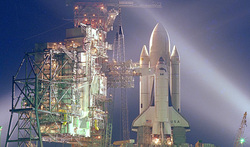
I do remember Gagarin’s single orbit of the Earth all those years ago, but at the time I didn’t realise the magnitude of the event in terms of human history. To use the old cliché, humankind had finally left its planetary cradle, even though it was only for a matter of less than 2 hours. Similarly from a political viewpoint, it was huge. The United States was still wounded, after being beaten in the race to orbit an unmanned satellite by Sputnik 1, and now Gagarin’s flight just served to twist the knife. It was this momentous event that spurred John Kennedy to make his inspirational speech, to throw down the challenge to the Soviet Union of a race ‘to land a man on the moon before this decade is out’! The rest is now history, and for me a distant memory. Getting back to Gagarin’s flight, and from the perspective of 50 years of experience of human spaceflight, I think we tend to forget just how courageous he was in offering himself for this first flight into the unknown. We honour his memory and bravery today.

 RSS Feed
RSS Feed
